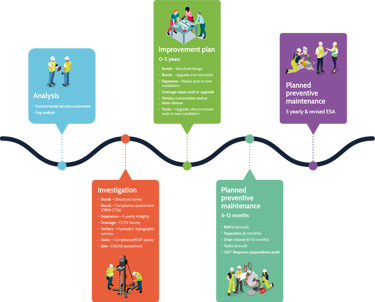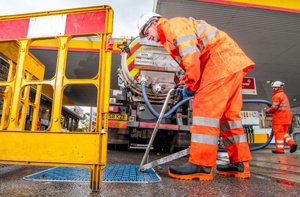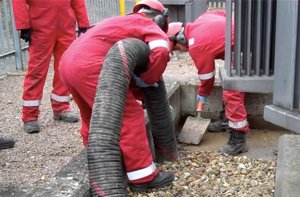
Baseline asset survey and gap analysis
We help site owners ensure their primary, secondary, and tertiary containment remains compliant with CIRIA C736 and associated standards and good practice, by offering baseline asset surveys and gap analysis so that they can be confident their assets will perform in the event of a pollution incident.
Legislation
CIRIA C736
Regulator issued CAR (Compliance Assessment Report) papers state that operators must provide evidence that their asset/facility meets CIRIA C736.
A baseline asset survey of each secondary containment facility should be completed and reviewed by a competent person to demonstrate it is reducing risk sufficiently to satisfy the law.
A gap analysis should be completed to highlight any shortcomings with the existing secondary containment facility compared to the class required by the use. Where practicable, these shortcomings should be addressed. However, if it is not considered practical then alternative measures should put in place such as tertiary containment to reduce the risk sufficiently to satisfy the law.
Duty holders should prepare an appropriate inspection and maintenance regime for their facilities. Where one does not exist, each containment facility should be classified. The classification should be reviewed at least once every five years, or where:
- there are any modifications made to the primary or secondary containment
- the volume of material in the primary containment is increased
- the nature of the material in the primary containment is changed.
Standards and guidelines
There are a number of standards and good practice for secondary and tertiary containment:
- BSEN 858-2:2003 Part 2 Separator systems for light liquids
- CIRIA C736 Containment systems for the prevention of pollution
- PPG 2 – Above Ground Oil Storage Tanks
- GPP 2 – Above Ground Oil Storage Tanks
- GPP3: Use and Design of Separators in Surface Water Drainage Systems
- GPP 21 – Pollution Incident Response Planning
- HSG 176 The Storage of flammable liquids in tanks
- HSG 51 Storage of flammable liquids in containers
- HSE/PSLG Safety and environmental standards for fuel storage sites
- Hazards 27 Inspection of Secondary and Tertiary Containment Systems
Features and outputs
- Baseline asset survey and gap analysis report.
- Understand your unique site risk rating.
- Recommendations on how to improve your primary, secondary, and tertiary containment.
- Compliance with CIRIA C736 and associated standards and good practice.
Baseline asset survey and gap analysis
This review of containment systems could be for environmental permitting reasons, following a regulatory enforcement or pollution incident, or due changes to a process or site.
The aim of this assessment is to consider the condition and suitability of the primary, secondary and tertiary containment (if required) for bulk storage and process vessels.
The baseline asset survey and gap analysis will include:
- Site visit to review and verify building features, plant, documentation and operational practices;
- Measure primary, secondary and tertiary containment provision, dimensions and capacities;
- Review construction methods for primary, secondary and tertiary containment;
- Review emergency response procedures and inspect equipment for spill response; and
- Assess primary, secondary, and tertiary containment against the requirements of CIRIA C736 and the Guidance for pollution prevention (GPP).
The report
The first part of the report will detail general site information including location and purpose.
Site risk rating
We produce a site condition report and environmental risk assessment following the Source-Pathway-Receptor model.

Source
We would identify all source hazards including raw materials, maximum amount present, annual consumption, and relevant data (including information from Safety Data Sheets). Using this information, we create a source harm index of low, moderate, or high.
Pathway
We then go on to assess risk from pathways at the site.
- We will consider the location of primary containment, the presence of secondary containment and the proximity to water drains.
- Below ground features such as services, ducts, pipelines, filled ground, tunnels, tanks or sumps.
- Location of on-site effluent treatment systems.
- A CCTV drainage survey to identify areas which require repair and replacement. [link to drainage survey page]
- The presence of entry points into the foul sewer system in process or storage areas.
- Topographic survey to identify gravity drainage
- Presence of soakaways on site and routing of surface water drainage.
- Presence of combined sewer systems on site.
- Ground investigation report including potential for infiltration of minor spills and leaks.
- Flood risk.
- Review bunds for potential to capture heavy rainfall rendering them ineffective.
- Bund has capacity in excess of containment requirements.
Using this information, we create a pathway transport potential index of low, moderate, or high.
Receptors
We will perform a search of the local area to identify:
- Known water abstraction points for public consumption within 2km of the site.
- Sensitive sites such as Sites of Special Scientific Interest (SSSI), Special Areas of Conservation (SAC) or Special Protection Areas (SPA) within 2km of the site.
- Nearby drainage channels.
- Surface water drains.
Using this information, we create a receptor potential index of low, moderate, or high.
The source – pathway – receptor indexes are combined to create an overall site hazard rating and a source hazard rating according to the methodology in Section 2 of CIRIA C736.
If the site is not subject to the Control of Major Accident Hazards Regulations 2015 (COMAH) a quantitative risk assessment for likelihood of loss of containment will be required including an assessment of Major Accidents To The Environment (MATTE).
We would assess the following factors that would reduce the likelihood of loss of containment:
- Significant loss of containment incidents at the site within the last 10 years.
- Above ground pipework reduces the likelihood of leaks or spills from pipework going unnoticed.
- Primary containment vessels which are located away from traffic routes reduces the likelihood of vehicle collision.
- The construction and condition of the primary containment vessels is observed to be good.
- The effluent treatment plant operates on a batch basis, requiring input from trained operators.
- Access to the primary containment vessels by vandals is not easy.
Baseline asset survey
A baseline asset survey should be undertaken to consider the condition and suitability of the primary, secondary and tertiary containment (if required) for bulk storage and process vessels at the site in accordance with Section 5.4 of CIRIA C736.
Our experts will identify and produce a report on the following including photographs as evidence:
- Primary containment – the contents, construction and condition of tanks used on site.
- Secondary containment – calculation of the volume of the bund to ensure sufficient containment. Identify the type of construction and any penetrations, permeability, and leak detection systems.
- Tertiary containment – identify any tertiary containment present and appropriate for classification and type.
- Potential leakage pathways – Identify the pathway of leaked product, where temporary containment could be located and any drains that could be impacted in the event of an emergency.
Once the report is produced our experts will provide you with recommendations on how to improve your primary, secondary, and tertiary containment.
It may be identified that an emergency plan is required, and our experts can guide you in the development of this.
When assessing your tertiary containment, our experts will ensure they align with the GPP3 flow chart to ensure the appropriate system is in place for their site.

Gap analysis
A gap analysis should be completed following the baseline asset survey to highlight any shortcomings with the existing primary, secondary, and tertiary containment facility compared to the class required by the use. Where practicable, these shortcomings should be addressed. However, if it is not considered practical then alternative measures should put in place such as tertiary containment to reduce the risk sufficiently to satisfy the law.



